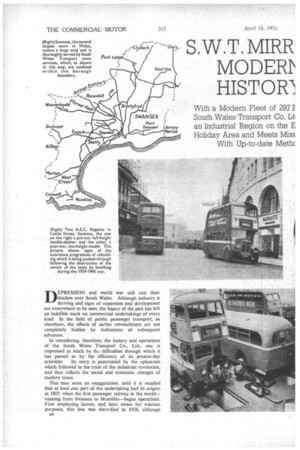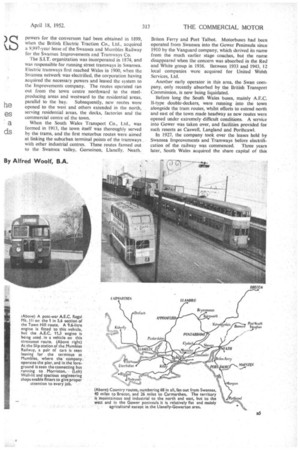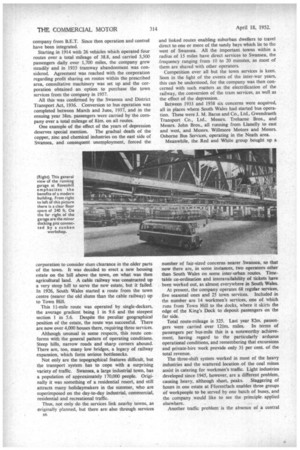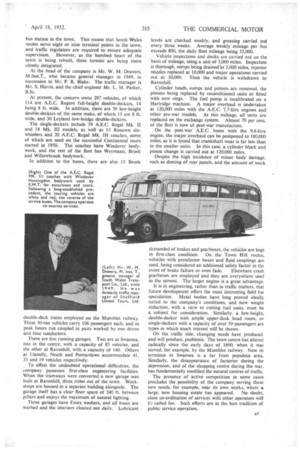stas S.W.T. MIRR MODEM HISTOM
Page 38

Page 39

Page 40

Page 41

If you've noticed an error in this article please click here to report it so we can fix it.
With a Modern Fleet of 297 E South Wales Transport Co. Lt1 an Industrial Region on the E Holiday Area and Meets MiXE With Up-to-date Methc
By Alfred Woolf, B.A.
DEPRESSION and world war still cast their shadow over South Wales. Although industry is thriving and signs of expansion and development are everywhere to be seen, the legacy of the past has left an indelible mark on commercial undertakings of every kind. In the field of public passenger transport, as elsewhere, the effects of earlier retrenchment are not completely hidden by indications of subsequent advances.
In considering, therefore, the history and operations of the South Wales Transport Co., Ltd., one is impressed as much by al.) difficulties through which it has passed as by the efficiency of its present-day activities. Its story is punctuated by the upheavals which followed in the train of the industrial revolution, and thus reflects the social and economic changes of modern times.
This may seem an exaggeration, until it is recalled that at least .one part of the undertaking had its origins in 1807, when the first passenger railway in the world— running from Swansea to Mumbles—began operations. First employing horses, and later steam for traction purposes, this line was electrified in 1928, although n4 powers for the conversion had been obtained in 1899, when the British Electric Traction Co., Ltd., acquired a 9,997-year lease of the Swansea and Mumbles Railway for the Swansea Improvements and Tramways Co.
The S.I.T. organization was incorporated in 1874, and was responsible for running street tramways in Swansea. Electric tramways first reached Wales in 1900, when the Swansea network was electrified, the corporation having acquired the necessary powers and leased the system to the Improvements company. The routes operated ran out from the town centre northward to the steelproducing areas and westward to the residential areas, parallel to the bay. Subsequently, new routes were opened to the west and others extended in the north, serving residential areas, the docks, factories and the commercial centre of the town.
When the South Wales Transport Co., Ltd., was formed in 1913, the town itself was thoroughly served by the trams, and the first motorbus routes were aimed at linking the suburban terminal points of the tramways with other industrial centres. These routes fanned out to the Swansea valley, Gorseinon, Llanelly, Neath. Briton Ferry and Port Talbot. Motorbuses had been operated from Swansea into the Gower Peninsula since 1910 by the Vanguard company, which derived its name from the much earlier stage coaches, but the name disappeared when the concern was absorbed in the Red' and White group in 1936. Between 1933 and 1943, 12 local companies were acquired for United Welsh Services, Ltd.
Another early operator in this area, the Swan company, only recently absorbed by the British Transport Commission, is now being liquidated.
Before long the South Wales buses, mainly A.E.C. B-type double-deckers, were running into the town alongside the tram routes, whilst efforts to extend north and east of the town made headway as new routes were opened under extremely difficult conditions. A service into Gower was taken over, and facilities provided for such resorts as Caswell, Langland and Porthcawl.
In 1927, the company took over the leases held by Swansea Improvements and Tramways before electrification of the railway was commenced. Three years later, South Wales acquired the share capital of this company from B.E.T. Since then operation and control have been integrated.
Starting in 1914 with 26 vehicles which operated four routes over a total mileage of 38.8, and carried 5,500 passengers daily over 1,700 miles, the company grew steadily and in 1935 tramway abandonment was considered. Agreement was reached with the corporation regarding profit sharing on routes within the prescribed area, consultative machinery was set up and the corporation obtained an option to purchase the town services from the company in 1957.
All this was confirmed by the Swansea and District Transport Act, 1936. Conversion to bus operation was completed between March and June, 1937, and in the ensuing year 38m. passengers were carried by the company over a total mileage of 81m. on all routes.
One example of the effect of the years of depression deserves special mention. The gradual death of the copper, zinc and chemical industries on the east side of Swansea, and consequent unemployment, forced the corporation to consider slum clearance in the older parts of the town. It was decided to erect a new housing estate on the hill above the town, on what was then agricultural land. A cable railway was constructed up a very steep hill to serve the new estate, but it failed. In 1926, South Wales started a route from the town centre (nearer the old shuns than the cable railway) up to Town Hill.
This 11-mile route was operated by single-deckers, the average gradient being 1 in 9.6 and the steepest section 1 in 5.6. Despite the peculiar geographical position of the estate, the route was successful. There are now over 4,000 houses there, requiring three services.
Although unusual in some respects, this route conforms with the general pattern of operating conditions. Steep hills, narrow roads and sharp corners abound. There are, too, many low bridges, a legacy of railway expansion, which form serious bottlenecks.
Not only are the topographical features difficult, but the transport system has to cope with a surprising variety of traffic. Swansea, a large industrial town, has a population of approximately 170,000 people. Originally it was something of a residential resort, and still attracts many holidaymakers in the summer, who are superimposed on the day-to-day industrial, commercial, residential and recreational traffic.
Thus, not only do the services link nearby towns, as originally planned, but there are also through services a6 and linked routes enabling suburban dwellers to travel direct to one or more of the sandy bays which lie to the west of Swansea. All the important towns within a radius of 15 miles have direct services to Swansea, the frequency ranging from 10 to 20 minutes, as most of them are shared with other operators.
Competition over all but the town services is keen. Seen in the light of the events of the inter-war years, this can be understood, for the company was then concerned with such matters as the electrification of the railway, the conversion of the tram services, as well as the effect of the depression.
Between 1933 and 1938 six concerns were acquired, all in places where South Wales had started bus operation. These were J. M. Bacus and Co., Ltd., Gwendraeth Transport Co., Ltd., Messrs. Treharne Bros., and Messrs. John Bros., all running from Llanelly to east and west, and Messrs. Wilimore Motors and Messrs. Osborne Bus Services, operating in the Neath area.
Meanwhile, the Red and White group bought up a number of fair-sized concerns nearer Swansea, so that now there are, in some instances, two operators other than South Wales on some inter-urban routes. Timetable co-ordination and interavailability of tickets have been worked out, as almost everywhere in South Wales.
At present, the company operates 68 regular services, five seasonal ones and 25 town services. Included in the number are 14 workmen's services, one of which runs from Town Hill to the docks, where it skirts the edge of the King's Dock to deposit passengers on the far side.
Total route-mileage is 325. Last year 82m. passengers were carried over 121m. miles. In terms of passengers per bus-mile this is a noteworthy achievement, having regard to the particularly arduous operational conditions, and remembering that excursions and private-hire work provide only 31 per cent. of the total revenue.
The three-shift system worked in most of the heavy industries and the scattered location of the coal mines assist in catering for workmen's traffic. Light industries developed since 1945, however, are a different problem, causing heavy, although short, peaks. Staggering of hours in one estate at Fforestfach enables three groups of workpeople to be served by one batch of buses, and the company would like to see the principle, applied elsewhere.
Another traffic problem is the absence of a central bus station in the town. This means that South Wales routes serve eight or nine terminal points in the town, and traffic regulators are required to ensure adequate supervision. However, as the bombed heart of the town is being rebuilt, these termini are being more closely integrated.
At the head of the company is Mr. W. M. Dravers, Minst.T., who became general manager in 1949, in succession to Mr. P. R. Blake. The traffic manager is Mr. S. Harris, and the chief engineer Mr. L. M. Parker, B.Sc.
At present, the concern owns 297 vehicles, of which 114 are A.E.C. Regent full-height double-deckers, 14 being 8 ft. wide. In addition, there are 59 low-height double-deckers of the same make, of which 15 are 8 ft. wide, and 30 Leyland low-bridge double-deckers.
The single-deckers include 39 A.E.C. Regal Mk. II and 18 Mk. III models, as well as 13 Renown sixwheelers and 20 A.E.C. Regal_Mk. III coaches, some of which are used on the successful Continental tours started in 1950. The coaches have Windover bodywork, and the rest of the fleet has Weyrnann, Brush and Willowbrook bodywork.
In addition to the buses, there are also 13 Brush double-deck trains employed on the Mumbles railway. These 30-ton vehicles carry 106 passengers each, and in peak hours run coupled in pairs worked by one driver and four conductors.
There are five running garages. Two are at Swansea, one in the centre, with a capacity of 85 vehicles, and the other at Ravenhill, with a capacity of 140. Others at Llanelly, Neath and Pontardawe accommodate 41, 33 and 19 vehicles respectively.
To offset the undoubted operational difficulties, the company possesses first-class engineering facilities. When the tramways were converted a new garage was built at Ravenhill, three miles out of the town. Workshops are housed in a separate building alongside. The garage itself has a clear floor space of 240 ft. between pillars and enjoys the maximum of natural lighting.
Three garages have Essex washers, and all buses are washed and the interiors cleaned out daily. Lubricant levels are checked weekly, and greasing carried out every three .weeks. Average weekly mileage per bus exceeds 800, the daily fleet mileage being 35,000.
Vehicle inspections and docks are carried out on the basis of mileage, using a unit of 5,000 miles. Inspection is thorough, sumps being drainent 5,000 miles, injector nozzles replaced at 10,000 and major operations carried out at 30,000. Then the vehicle is withdrawn to Ravenhill.
Cylinder heads, sumps and pistons are removed, the pistons being replaced by reconditioned units or fitted with new rings. The fuel pump is recalibrated on a Hartridge machine. A major overhaul is undertaken at 120,000 miles with the A.E.C. 7.7-litre engines and other pre-war models. At this mileage, all units are replaced on the exchange system. Almost 70 per cent. of the fleet is now of post-war manufacture.
On the post-war A.E.C. buses with the 9.6-litre engine, the major overhaul can be postponed to 180,000 miles, as it is found that crankshaft wear is far less than in the smaller units. In this case, a cylinder block and piston change is carried out at 120,000 miles.
Despite the high incidence of minor body damage, such as denting of rear panels, and the amount of work demanded of brakes and gearboxes, the vehicles are kept in first-class condition. On the Town Hill routes, vehicles with preselector boxes and fluid couplings are used, being considered an additional safety factor in the event of brake failure or even fade. Elsewhere crash gearboxes are employed and they are everywhere used to the utmost. The larger engine is a great advantage.
It is in engineering, rather than in traffic matters, that future development offers the most interesting field for speculation. Metal bodies have long proved ideally suited to the company's conditions, and now weight reduction, with a view to cutting fuel costs, must be a subject for consideration. Similarly, a low-height, double-decker with ample upper-deck head room, or single-deckers with a capacity of over 50 passengers are types in which much interest will be shown.
On the traffic side, changing needs have produced and will produce, problems. The town centre has altered radically since the early days of 1800, when it was served, for example, by the Mumbles railway. Now its terminus in Swansea is a far from populous area. Similarly, the disappearance of factories during the depression, and of the shopping centre during the war, has fundamentally modified the natural centres of traffic.
The presence of active competition in some cases precludes the possibility of the company serving these new needs, for example, near its own works, where a large, new housing estate has appeared. No doubt, close co-ordination of services with other operators will 6:: called for. Such efforts are in the best tradition of public service operation.












































































